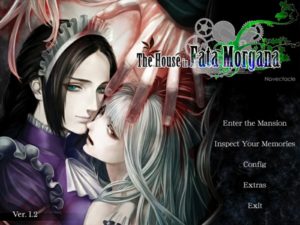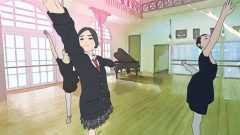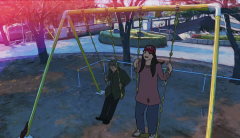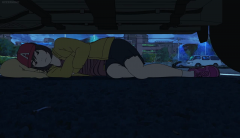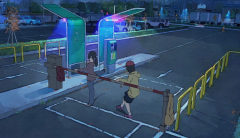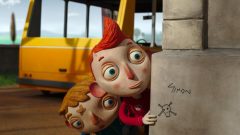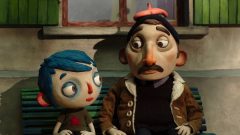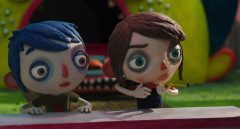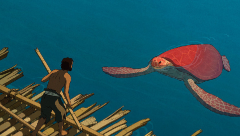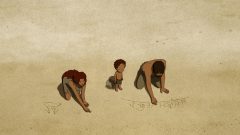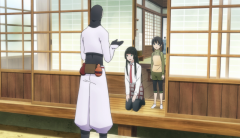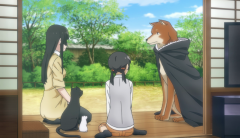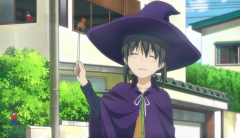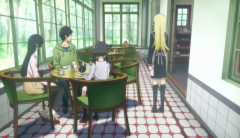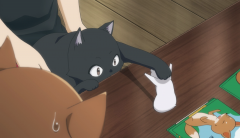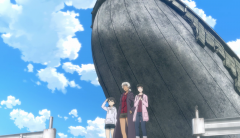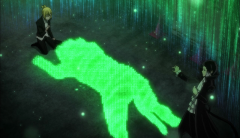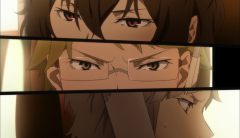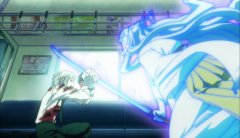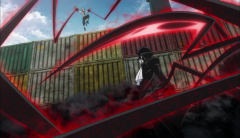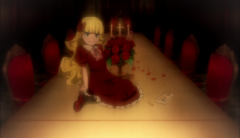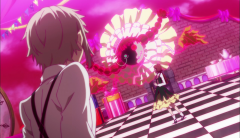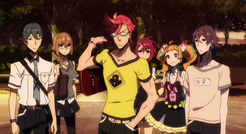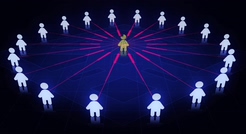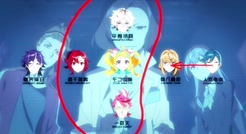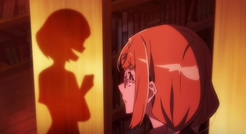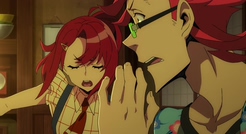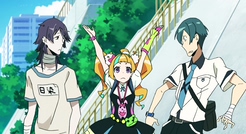Well I promised I would do a review of this visual novel quite a while ago and believe it or not I only just got around to finishing it. If the fellow who requested it is still here then here you go, I kept my word. Anyway it has been a while since my last game review and I have been itching to cover more visual novels on this site. What better way to jump back into the fray than with The house in Fata Morgana made by Novectacle in 2012(2010 if you consider the trail version) but recently localised by Mangagamer and published on Steam on May of this year. Now this game is a strange beast for a Visual novel. Usually a VN has a main protagonist who lives in Japan and has a number of female friends who act as alternate routes and stories depending on who you choose to partner up with. Fata Morgana doesn’t have that and just in case you were thinking it, it’s not an Otome novel either. (AKA, what i just described but with male friends) Instead what we have here is a visual novel set in the west forgoing the usual anime style for a more comic book/gothic portrait style with a story that is akin to anthology of tragedy tales. For those concerned about censorship, there is none here as this game was all ages, meaning it holds no pornographic content. Don’t take that to mean that it isn’t dark or gory because I can assure you that is most certainly not the case. In a world where in the vast majority of cases you primary concern is choosing your first waifu, this game sticks out and very much in a good way. Don’t take it that I consider visual novels to be generally trash, this is more like the anime industry were for very interesting title you have a truckload of terrible fanservice fantasy harem battle anime. Only difference here is that unlike the anime industry, the dozens of visual titles coming out are not all translated, leaving potential greats sitting in the visual novel database unread due to no English translation. As a prime example, Baldr Sky which has held a spot in the top 5 visual novels of all time in VNDB since 2009 is only just now getting an English translation. It honestly pains me when i think of the numerous potential great titles which escape my grasp due to a lack of a translation. But alas let us move on.
Continue reading “The House in Fata Morgana Video Game Review – 83/100”
Category: Anime Reviews
Tokyo Mirage Sessions ♯FE Review – 65/100

The title of this game rather says everything you need to know about my initial reaction, and I’m still all around puzzled at the mixed bag that this turned out to be – it IS just a standard mashup while having a bit of fun with some experimentation, but the game itself is actually a jumble of Persona’s mechanics with some hints of Fire Emblem, Final Fantasy X-2 masked behind a colorful anime-esque fatigue. Originally called “Shin Megami Tensei x Fire Emblem” but changed shortly thereafter to “Tokyo Mirage Sessions,” I decided I’d have an open mind about this before I went into it, without looking for comparisons to the Persona or Fire Emblem aspects of the game, and did actually enjoy the gameplay. But by the end of my second playthrough, it turned out to be a mediocre title that failed to consistently interest me as a standalone title, much less as a fan of both Fire Emblem and Shin Megami Tensei.
The story is entirely original, so it’s not required that you play any of the Shin Megami Tensei or Fire Emblem titles for you to dive into it unless you want to understand certain references. The story begins with our protagonist in some talent agency in Tokyo as he learns how to utilize an energy called Performa and attract beings known as Mirages much like in the Persona series. The rest of the plot is pretty by the books, it has cameos/references to Fire Emblem and Shin Megami Tensei characters to keep you interested in the plot, and in between the unnecessarily text-heavy story are the animated cutscenes by Studio 4C, which are all serviceable except for the poorly integrated CGI during music/dance sequences (which I believe were done by a different studio). Although Japanese pop isn’t really my favorite genre of music, it’s well produced to say the least and the background soundtrack isn’t too generic either, they accompany the combat really well as the fights feel like a performance rather than a traditional RPG battle.
Continue reading “Tokyo Mirage Sessions ♯FE Review – 65/100”
Kizumonogatari Part 1: Tekketsu-hen (2016) Movie Review – 85/100
Just a quick note that I originally intended this week’s review to be about Miss Hokusai. But because of the DVD release of this Kizumonogatari (with good subtitle to boost), I decided to bump this up and review it instead. Monogatari series has been among one of my favorite series, and certainly the one that I spend time the most. Sorry Miss Hokusai but you will have to wait for few weeks later. When it comes to Monogatari series there’s simply no competition, okay? Now, let begin.
It’s always a tricky line when you are making a TV movie when you think about it, because you have to please both the fans of the series, along with new audiences who never see the series before. In other words, you have to make a movie that maintains the elements, tone and themes that make the series famous, at the same time the movie has to have something that can stand on its own. In that regards I always consider that The Adolescent of Utena is the best TV movie adaptation ever in anime. The way it reimages the plot of the original show, updating the settings, altering some plot points, and then goes completely bananas with its theme. Kizumonogatari has a bit of advantage, since it is also based from the light novel as a prequel to Bakemonogatari. The film was originally announced to be adapted right after the first series, back in 2010. Six years past, with the presence of many following seasons, there were doubts whether or not Shaft going to adapt it at all. Then comes the announcement of not one film, but a trilogy. This movie is just the first part of the trilogy, and clocking at exactly 1 hour, the film doesn’t hide the fact that it’s not self-contained, instead the film pleases itself of placing a groundwork for more events to come in latter parts.
Kizumonogatari part 1 nails many of the show’s distinctive features. Audiences who already love the series will find a lot to enjoy here. There are long, snappy dialogues, the distinctive but messy style of visual, the sharp impressionist art backgrounds, the insert screen texts, the ecchi undertone and of course the head-tilts. They’re all here. Its quick styles of visual prove to be too much for some, but never fail to impress (there’s a reason that my avatar is from Monogatari). The color palate changes according to the mood the characters are in or the topics they conceive. Monogatari is one of the few examples on how a great adaptation should be, in the sense that they don’t need to adapt it faithfully, but take the tone, the theme of its source material and turn the show into a very distinct visual feast (The Tatami Galaxy is another example). After all, light novels and visual anime shows are two different mediums, there is something that work well in one medium but will not work in another, hence taking an artistic liberty to the source is a very necessary task. Many characters that we come to know and love has returned for the film, or to put it more correctly, appear for the first time together. It’s actually very nice to see those characters before everything happen, when they are still insecure and naïve.
Yet, this movie sets itself apart from the series for so many reasons, or I should say, this movie is an update version from the series. While usually I don’t like the use of narration, Monogatari series is one of the best example on how to use the voice-over right. Because every character in the show has their own distinctive voices, using narration to understand the way they think, the worldview they possess feels deeply personal. Yet in the movie, the inner voice is stripped down and what we have instead is the external experience. The film shows what the characters experience through pure visual storytelling instead of relying on what the character’s inner thought. The first sequence of the film is the perfect example of this approach to create a sense a paranoia we feel along with our main character Araragi. We literally follow our main character’s every footstep, see what he sees, hear what he hears. In the sequence, Araragi wanders around an abandoned building. He’s shaking and terrified, completely out of place. It is a nightmarish situation in which Araragi couldn’t get out of and we sense his uneasiness. All this were achieved without any spoken dialogue.
Moreover, if there is one element that truly stands out in the film, it is the sound designs. The film uses a more jazzy, popular melodic soundtrack that fits the scenes they play like a glove. My favorite piece of soundtrack happens when Hanekawa and Araragi meet up for the first time after the “incident”, the soundtrack goes Latino and sweet and upbeat, but later when Araragi encounters the vampire Kiss-Shot, the soundtrack goes dense and off-putting. The sound, or the lack thereof, complements the movie in so many way as well. I have to note that the sound designs, just like the visual presentation, are highly unconventional. The film use sounds like the tickling clock to represent the sexual tension of Araragi when he thinks back about Hanekawa’s underpants and big boobs, or use baby cries to substitute for the desperation of Kiss-shot when our main character refuse to help her, or the distorted sounds of people talking to illustrate the un-humanness Araragi is becoming. The more I think about those sound designs, the more I believe that the movie has outdone the series in so many level. The settings also get new designs: the old abandoned cram school, the high school and Araragi’s house have these new looks and it’s a joy to watch. As did with our characters. The characters have their own distinctive appearances and ask me which hairstyle fit Shinobu better, I would choose this one without hesitation. Unlike the series that I have mentioned earlier, the color palate in the film is dominated by the bright yellow and orange colors, which for me is very suitable, since Kiss-Shot has yellow hair (and she’s very important to this story), the yellow ray of the sun (which also very fitting with the theme) and most of all it makes the blood looks less terrified.
Story-wise, the film contains 3 parts: Araragi and Hanekawa meet for the first time; Araragi finds a limbless vampire Kiss-Shot on a verge of dying and decides to help her; Araragi on his mission to retrieve Kiss-Shot limbs in order to reverse back to human, with the help of Oshino Meme, a “negotiator”. Actually, for those of you who curious, the very first opening section of Bakemonogatari is basically a very quick overview of Kizumonogatari and contains the prequel’s most important scenes. Now I don’t encourage you to watch that to spoil yourself, but you might check it out to see the different in approach and design between that “preview” and the actual movie. That is for me what Kizumonogatari would look like if it were adapted 6 years ago. The second part of the film is easily the best part of the film, the way it mixes the natural world of the first part and the supernatural world of the last part, in addition with the visual and sound designs to create an eerie and quite disturbing atmosphere. Monogatari has tackled difficult and even depressing subjects before (the whole Sodachi’s acts), but this is the only time where they manage to put the viewers in and make sure us stay there with Araragi with an unflinching look.
So what’s to expect for the next two movies then? Oshino Meme mentioned that the whole thing now is too unbalanced that he can’t help but to step in; and he is the negotiator who bridges between here and there. Araragi thought that this is them (Araragi and Kiss-Shot – the Vampires) against human (the Vampire executors), but then Meme remarked again that Araragi and himself are human. If he can pick up something from that, he should have realized the reason Oshino Meme steps in is to help Araragi against Kiss-Shot. She’s hiding something and at this moment she just manipulates Araragi in order to get her full power back. Like the film states clearly in the beginning, “This story about a vampire has an unhappy ending – It concludes with everyone becoming miserable”. Don’t expect a joyous ending here, but that’s precisely the reason I look forward to the next movie.
Overall, Kizumonogatari part 1 is a worthy successor to the series, and a major step up in terms of production values and its visual storytelling, which is a feat itself consider that everyone have an extremely high expectation from it. Still, I have a hard time to score it alone as this one is clearly just a set up for more to come, but at least I could say that it succeeds in what it sets out to do. Lastly, to the question whether this movie would be a good place to start for newcomer. Well, I always prefer to go with the airing order, because they have been written that way (Kizumonogatari would be the third release in light novels). But I’d say the newcomer would welcome to watch this, because the movie both maintains many trademark elements from the series, and it’s chronically a beginning of its all. The only downside with this is you then have to wait for almost a year for the full trilogy to come out and it’s no fun waiting.
Next post, I will review one of my favorite film and personally the best animated film of this decade so fa… scratch that, this is one of the best film of this decade so far in any form, animated or not. Expect a high score here. Stay tune!
~SuperMario~
The Murder Case of Hana & Alice (2015) Movie Review – 85/100
Welcome to the third installment of World Animation section, but this time we head back to Japan for my favorite anime movie out of last year. If anything, I have always wanted those reviews to be a recommendation if you want to look for something different. So if there is anyone who would check out the films after reading those reviews, then I consider those posts a success. I know myself checking out a wide range of movies just because I read reviews that I enjoyed, so I hope I could offer the same here. Unlike those first two movies that I happened to watch in certain film screenings, from now on those movies that I review are available online or on streaming, so if you feel interested then by all mean go check it out yourself.
The Murder Case of Hana & Alice (or just simply The Case of Hana & Alice) is a prequel of a 2004 live-action movie Hana & Alice. The film divides into two separate parts, which contains even different sets of characters besides the titular Alice. We follow every steps of Alice as she familiars herself with the new environment in the first part; noticing the mysterious neighbor who spied on her (that would be Hana), being bullied in class for breaking the “curse seal”, having a chance to play ballet, meeting her father, participating in relay, and investigating a superstitious “murder case”. The second half we have her teaming up with Hana in an attempt to find whether the real victim was dead or alive, which leads to the many misadventures along the way.
If there is one thing that you immediately notice while watching this film is that the film looks and feels more like a live-action movie than anime. This is true in a sense since the director Shunji Iwai is famous for his live-action films and The Case of Hana & Alice was his first anime attempt. The shots compose is more of live-action sensibility than animation as well. Take for example the motifs of tracking the characters walking through the streets in a profile shot; while we have that kind of shot in anime, it’s usually used very quickly to show the characters talking to each other. Here in the film they use a good 10-20 seconds just to follow those characters literally just walking, either alone or together. The character designs, since they are modeled from real actresses, look more realistic than our usual anime designs. The color is always on bright scheme, with the mixture of real life building and pink/green-dominated background. It produces a more impressionist look and honestly I like the look of the movie. The music is easily one the best component out of this film, which composed by the director himself. It contains both piano score and violin score resembling a ballet score. If you close your eyes and just listen to the music, you can really feel the flow of the music and the mood it creates. It’s that good.
In addition, the decision to make this film an animated one was more of practical choice than artistic choice. The director wanted to use the same actresses from the original movie to display an even younger version of them, as a result he had to use rotoscoping to avoid ageing the actresses. To put it simply, rotoscoping is a process of filming live action footage (with real actors of course), then retrace it frame by frame by either re-drawn it or using computer software. Rotoscoping has been used before in anime, quite controversially even, in Flowers of Evil, to suggest an eerie and uncomfortable sense to our viewers, but in this case, the use of rotoscoping produces a very different outcome: a floating sense. That floating sense plays both as its strengths and as its shortcomings. On a plus side, this suits the most for ballet dancing, since you know, ballet dancing is already like floating across the floors. Many of the ballet sequences are easily the highlights of the movie, both visually and as a statement of how to use the technique right. On the negative side though, the weight of the characters always seems off, as a result we feel the characters “just floating” in many moments, most noticeably the first sequence where Alice falls off from her window and was “catch” by the worker, or later whenever Alice’s running. On other notes, the disparity between characters who were drawn from actual actors and those fictional characters is just jarring. The designs of the worker mentioned earlier or the triplets with bikes in the end felt really like they came from Tintin universe (with big-dot eyes and cartoon face) and to put it together with a much more realistic designs of the mains, you feel like you’re watching two different movies at the same time.
The biggest selling point of the film is, of course, the characters themselves and the dynamic between the two main girls. On that front, the film shines the brightest. This is the kind of characters I love to follow, not because they are the deepest, but because they’re full of identity. There are many vivid little moments that showcase this quality, as mundane and realistic as possible. From Alice punching the book written by her mother in a bookstore, to a moment where she found the last piece of snack, to the moment where the two girls practicing ballet out at night. Make no mistake, the staffs really love their characters and we feel that love throughout the movie. They are not your typical teenager high school protagonists, Alice is a girl that acts on impulse, she’s direct and doesn’t afraid to speak her mind; but she’s surprisingly down to earth and sincere as well or Hana is not your typically shut-in character, as she’s actually smart and quick-wit, and her guilt that she might be responsible for the death of her close friend makes her a more realized person than most other main characters we see in anime shows. Furthermore, they bound off each other very well, mostly because they have so different personalities, yet they can share the pain to each other. The other side characters, in general, provide enough charms and again, “personality” to make them stand out too: Alice’s mother is wise enough but often shown as childish, Mu is fantastic with her unique-but-nonsensical quirks.
Another note that I find really interesting is that the whole film is decidedly female-centric cast, with the men only appear as either faraway (both Alice’s father and Yuda) or as weak and dependent (Alice’s father mentioned that he didn’t have a mindset to become a top runner, the bullying boy who reveals that he does it to save face, Yuda who is insecure about love and the idea of commitment). The only real male cast that was portrayed in different light is the old man. He’s representing the contrast between his old-self with the youthful, full-of-life of Alice. The sequence that speaks best to that idea, when Alice playing on the swing, stating how long it has been since her last play (2 years), the old man just sits quietly there in the next wing, his body feature looks no different than the old man in Ikuru, he told her that it has been 40 years since he played, because it was the time when his daughter was still in elementary school. This sad, melancholic tone mix in so well with the youthful of Alice. This is really the heart of The Murder Case of Hana and Alice- a film that celebrates the youthfulness, of how it’s like to feel young and enjoy the little moments of your life.
It’s criminal that The Murder Case of Hana & Alice slipped under the radar of most of anime fan. Surely it doesn’t look like your typical anime but I will say that there won’t be any anime like this in the near future. This is a rarity even among anime fandom. I haven’t watched the original live-action film, but surely after watching this I’m eager to check out the movie, just so that I can spend more time with those characters again.
Next post I will review the best written anime movie out of last year. And this time it might be the one you think it is. Stay tune!
~SuperMario~
Legend of Legacy Review – 80/100

Oh Square Enix, this is the kind of avant-garde work you need to do. Developed by Furyu with the people behind SaGa, and written by Masato Kato of Chrono Trigger, I knew I was in for a unique game right from the start. But its gameplay is certainly divisive and for good reason, as this is surprisingly much more out of the box from what you would’ve expected after SaGa. Most prominently, it has a style of story progression that allows you to quite literally go forward however you please – by opening up the world to you through unlocking maps via unstated objectives. Now, I don’t favor open world titles above linear games just for the sake of them being open world, but I do appreciate it when they’re done as well as it is here. I could play through Legend of Legacy as quickly or as slowly as I pleased in whichever order, with the intention being making the player feel like a real adventurer exploring uncharted territory, which it succeeds in spades all the way to the end. So if you’re coming out of Bravely Second rather dissatisfied, Legacy unwinds those linear genre conventions and shares more similarities with A Link to the Past in its range of freedom. Even the individual map’s bosses are more often than not just a part of the scenery as they roam the map aimlessly alongside the other mobs. But in exchange, the game can be brutal when you don’t know how to progress any further after fully exploring an area (while refusing to look at walkthroughs) and scouring the entire map looking for any possible clues. But this is also what adds charm to the game, as the game allows you to sell the maps you complete by exploring more of the wilderness. The more of the map you’ve filled, the more money you can sell them for, and it’s pretty rewarding to earn large sums of money for them.
Yet on the other hand, it’s worth noting that the turn-based combat is about as traditional as one can get apart from its lack of any level system. There can only be three characters at a time in your party, and in-battle you can utilize the elemental spirits in your environment for various effects like HP regeneration while customizing your stances outside of battle to affect turn order and defense. As a result, building an effective party is critical, yet also entirely up to you, and since there’s only so many roles possible in a 3-person team you’ll have to make sure everyone pulls their weight. Upon a new game, you can choose a protagonist among a huge selection of characters to begin your story with, and choosing the right character from the start makes the confusing lack of narrative that much better. I personally chose Filmia (the awesome frog that’s an obvious throwback) despite his rather one dimensionality in combat, as I found his small quips that much more interesting. In the small town of Initium, you’ll see the characters that you didn’t choose on the starting screen wandering about for you to recruit, and it’s really up to you to make sure everyone stays leveled up. I decided not to change up my starting trio of Filmia, Bianca, and Liber very much, as my play style is always offensive and Filmia is rather bulky anyways. But what makes the turn-based combat a little more interesting is its integration into the exploration mechanic – however much HP your party lost in-battle doesn’t entirely carry over into the next encounter, unless a character went down to 0 in which case they’d be at a fraction of their full HP the next battle. This means that as you go deeper into the wilderness, the less comfortable you are facing stronger enemies – so it encourages you to go back to town every now and again to sleep, restock, and retread. If a battle gets too tough you can always run away to the start of the map.
In any case, the game is extremely tedious if you don’t have interesting members in your party, as you’re going to have to grind in order to raise the level on your attacks and stats. Heaven forbid you start with Meurs or Owen as they’re the blandest characters in the game. As with any of these games that allow you to choose your protagonists, your experience may vary depending on the narrative you develop for your own party. As I like to mention in any of my previous reviews, it’s important for this kind of game to be a good character story over any kind of overarching plot, and most of these characters are interesting enough to keep your interest to the end. In this way it really does remind me of Rune Factory 4. Legend of Legacy is an excellent game to sink hours into if you don’t mind traditional turn based combat and hands off free-roaming. The plot is simple, yet clocks out over 40+ hours. But because of this, all of the characters in your party don’t feel like cutouts and get fleshed out believably, and the buildup gets used well by closing off satisfyingly. So yeah, it’s not a game that’s going to be very important to Masato Kato’s repertoire or to the 3DS RPG genre, but what it does well, it does well in spades. It does have its weaknesses where it goes too far in its efforts to let you do whatever you want, by sacrificing any sense of a greater purpose to your gameplay, but it works alright without one. To top it off, visually, the game is perfect. You can see influences of the SaGa games where they like to spam the screen with useless objects (like a giant conch, ruins, etc) but also the more subtle things. Each of the characters walk in their own unique way, and the characters move with their own unique poses and styles. This game is nearly a year old and I haven’t seen much buzz about it and it’s truly a shame. While games like Bravely Default continue to earn praise for its “traditional” gameplay, it’s games like Legacy which are the true throwbacks to a time when a game’s story was simply something to be discovered through gameplay.
| Storytelling: | 7/10 Open ended, it depends what you make of it on your playthrough. |
| Gameplay: | 7/10 Very traditional combat, but a unique story progression system and an interesting cast of party members keep everything from becoming too tedious and stale. |
| User Interface: | 8/10 Convenient quick saves, but otherwise a laughable options menu without even text speed adjustment. |
| Production values: | 10/10 Looks great, and the score is amazing. |
Suggestions:
Bravely Default/Second (3DS)
Rune Factory 4 (3DS)
Etrian Odyssey (DS)
My Life as a Courgette (2016) Movie Review – 82/100
It’s never easy to make a good family’s animation. For movies aim at adults, the filmmakers can easily get themselves loose, go crazy and the audience can still get it. But for kids, these movies might be one of the first movies they’ve ever seen and that’s a huge responsibility. They have to aware of children’s mindset all the time so that they both maintain kid’s interest throughout its screening time and make them invested to the story. That’s a reason why usually a good family movie or show tends to be either inspirational, educational, or packs an emotional punch for viewers of all ages. My Life as a Courgette falls neatly under the latter category. The film is adapted from a French children novel and the screenplay was written by the talented Celine Sciamma (she directed handful of movies and all of them focus on teenage girls and their transitions to adulthood, in other words, my kind of films). Though not as dark as the book, it’s a story from a kid’s point of view that have a very adult concept and tough subject matter.
The film recounts a few months in the life of Courgette, a nine-year-old boy, who accidently kills his alcoholic mom, then finds himself in an orphanage. His real name is Icare, but he insists of calling himself Courgette since it’s one of the very few things that he has left from his mother. Indeed, when he steps into the orphanage, the only things he keeps in his suitcase are an empty beer can from his mother, and a kite he made by himself. He doesn’t remember much about his father either, since the father left the family long time ago to chase “chicks”. There in the orphanage, he, still feels responsible for the death of his mother, encounters other kids who – like him – had experienced rough childhoods. They include the self-appointed leader (and a bit of a bully) Simon, and later Camille arriving by court order, who witnessed her parent’s murder-suicide. Rosy, whose mother was sent back to Africa. Ahmed, whose father was arrested for robbing a convenience store. Alice, whose father was arrested too. There is also a kind-heart policeman Raymond who later would be Couragette father’s figure as well.
If you feel I give a bit too much of a synopsis here, this is because it’s essential to the theme of the story. The best thing about the film, I have to say, lies in its sensitive writing. Within the first 10 minutes, the film successfully establishes a solid ground of all the mishaps, all the sadness these children have been gone through. Those moments feel so real and hold so much power. Life is not fair in the first place, and those children did nothing to deserve it. They all end up here, without the care of no one really, and all they have are each other. Being said that, those sad, downbeat times are just a facet of life, and learning how to live with it is the main theme of the film. The later part of My Life as a Courgette comes to more light-heart, sincere territory, but by then we’re already swept by the sadness that the whole movie feels more like a bittersweet experience.
Upon making this feature, the director Claude Barras insisted that he took extra attention to the eyes of the characters, and it shows in the movie, as the characters have big, expressive eyes. In many of the touching moments, those eyes help conveying a lot of emotion and we really see the sadness behind those eyes. The character designs, with big head, multicolor hairs and very thin body, further make those characters easy to root for, and will definitely catch the interest of the children. It helps of course that the kids were well-written and speak like a normal 9-year-old would speak. The stop-motion for the most part is serviceable; they serve the story well but nothing to stand out and truthfully judging from technical aspect there is nothing to recommend either. Then again this film is a children movie so I guess it serves its purposes.
If there is one thing that I could criticize the film for, that is its conflicts resolve way too quickly. There are two main conflicts of the film. The first conflict comes from Simon bullying Courgette, both because of his name and because he’s new. The second comes from the group’s attempt to win back Camille from her aunt who intends to use the girl for government-aided. I really think more time spending to raise the stakes would benefit the film better, especially with its relatively short running time (66 minutes to be exact). Because of its brief running time, only Courragette and two more characters (Simon, Camille) have a chance to develop, and boy! They certainly grow a lot during their brief time staying together in the orphanage.
In the end, My Life as a Couragette is the kind of film that the kids can enjoy but there’s a level for adults to appreciate as well. The bittersweet moments are all well-earned, and this is a feat to tell a sad, dark story without being too cynical or depressing. The film actually suggests the opposite, that unfortunate things happen everywhere, but learning to bounce back and stand up from those mishaps is something worth treasuring for.
Next post I will review my personal favorite anime feature film that came out last year in 2015, and it is NOT the one(s) you think it is. Stay tune!
~SuperMario~
The Red Turtle Review – 93.5/100
Welcome to my first movie review on World Animation section, the column where I wholly dedicated to indie/ art-house animated features around the world that hardly got coverage anywhere really. And what’s a better way to start this section by reviewing one of the most talked about animation movie this year, the one that I believe will continue to gain more devoted fans for years to come. The one that debuted back in Cannes this year with rave responses. Yes, let’s get to The Red Turtle today.
The Red Turtle is a brainchild of the director Michael Dudok de Witt and Studio Ghibli. If you never heard about the director, he’s an auteur animator who directed award-winning shorts Father and Daughter, the short was so acclaimed that many big animation studios approached him to direct their blockbuster movies, all of which he declined. Then one day he received a letter from Ghibli Studio stated that they thought his shorts looked very Japanese and they wanted to make a film with him. If you think the involvement of Ghibli could make this movie a more anime influences, you got yourself in a bind there, because this is unmistakably a Dudok de Witt film with more of European arthouse sensibility, with the slow and deliberate but confident pacing, and the film is more about sense and experience and many details are more open to interpretation than offer any precise meaning.
Looking from the outset, the film sounds like a really challenging work. This is a dialogue-free film about a man who washed away to a deserted island. He tries every opportunity to escape from the island, but always get disrupted by the giant red turtle. Then the man and the turtle form a closer relationship to each other and ultimately the man finds a way to adapt to his new life. And that was just the first 15 minutes of the film. For a full length feature film with no actual dialogue, it’s a feat that the movie maintains the attention to the very end. Indeed, trying to explain the plot of a film, or trying to recapture it in words, is already a disservice to the film. The Red Turtle is a film in its purest form, a visual storytelling that will lost its impact if it gets portrayed in any other forms.
Apparently, Dudok de Witt initially planned to have a main character to speak to himself, like what Tom Hank character did in Cast Away, but then he scrapped the idea since he felt that the dialogue (monologue?) was too unnatural. But without dialogue doesn’t mean this is a silent movie. The sound of the movie, that include both natural sound and the score, is one of its greatest achievement. The sound helps assist us to follow every steps the main character takes, really put us in his shoes as we follow him around. Those sounds create a whole surrounding very detail too, close your eyes and you can hear the wind breezes, the waves of the ocean, the steps of the man and those animals at the same time. The score is equally impressive, at most times it’s slow and tender, but other times thrilling and exciting (like the very first scene or during the flood sequence). Visually, Dudok De Witt implies a very plain character designs against a natural but well-detailed and rich world the main characters inhibit. The background is expressive, with too much details was put on it. From the bush trees, the little crabs who seems to follow the waves, the baby turtles go around the bench, all these really create an atmosphere to the island. The animation and the shot selections are all top-class, which holds much of our attention throughout its 80-minutes length.
The film maybe about a man who float in an island, but the plot never feels plotless. Everything happens contribute to the main themes, which are the connection between human and nature and the passage of time. The film chronicles the man who struggles to find a place in a nature that clearly not for him, to him having a family and has something to hold on to. As the man got older and wiser, he himself realizes he’s just a small part of the world, like every plant, animals around him. His passed away in the end is just as well a part of that cycle of life.
It’s rare today that can give a work that are original, mature and ambitious as The Red Turtle, especially against the backdrop of the dominance of computer animation in feature-length movies for the last 20 years. The Red Turtle, with its simple hand-drawn techniques, already feels like a timeless production, and the film is even more significant given the fact that this is co-produced by the beloved Ghibli, now on its semi-hiatus phase. While this film bears little resemblance to Ghibli’s original outputs, this is clearly a production of both the director Dudok De Witt and Ghibli; in a sense that The Red Turtle would not exist without those two. With so much efforts were put on this picture, it’s the more astonishing to realize that the film had achieved something so difficult to attain: simplicity.
Next post in this column I will review the film that just won the Annecy Festival this year. Stay tune!
~SuperMario~
Flying witch Review – 86/100
As I mentioned in one of my weekly posts, most of the reason why a slice-of-life anime show don’t work well is not because there’s nothing happen, but more because the cast isn’t interesting enough or the show tends to repeat the things that we already know. I’m happy to say that this is not the case for Flying witch. Flying witch has all the elements good slice-of-life shows have and moreover it presents itself as one of the finest in the genre in years. The slow and deliberate pacing and the strong sense of atmosphere maybe the whole reason why people keep coming back to watch it.
Story-wise, the show focuses on two main themes: the first theme is how Makoto the witch learns and lives her rural country lives. There are segments that as mundane as possible: Makoto learns to plant, the cast cooks hamburger, they go for herb-picking or thinning the apple trees. But the details they put in both show how they really care about the process, and help maintaining the relaxing atmosphere till the end. In Flying witch world, time will pass and people may get old, but growing plant, eating hot cakes and wandering around might be the best ways to spend your day. The second theme is to produce a mix of magical realism in this everyday life. By introducing new characters: The Harbinger, another witch, the witchcraft, the witch café or at the end the flying whale and Earthfish, the show showcases a sense of wonder, a touch of magic that feels almost like, well, actual magic. It helps that the introduced characters are endearing and have a very easy chemistry, they are both display on how each of us is different and have different purpose from each other, but ultimately we are all part of mother nature.
Aside from the atmosphere, the cast is easily one of the highlights of the show. Rarely in anime that I see a cast who feel really natural and thus, true to life like our friends around us. Chinatsu, for example, acts exactly like how 12-year-old girl would act. Her ever curiosity, her excited over whenever she encounters new things, are so natural and exactly herself. Chito the cat acts like any normal cat would, and then some. Indeed, one of the greatest strength of the show is how everyone in the cast are so consistent, yet each episode we could learn something new about them. Like we only learn that Nao is so clueless in kitchen on the last half of the show, or until the second encounter that we learn Anzu is really knowledgeable about history. Each of the cast also fits in the shows perfectly and it has been so long that I found myself enjoying so many characters like this one. Moreover, the chemistry between the cast is what makes this show shines so much. I always enjoy little moments shared between some of their cast: like back-and-forth conversations between Chinatsu and Inukai, or Nao and Chito the cat, or Anzu and Kenny the white cat. The chemistry between the siblings: from Kei and Chinatsu, to Makoto and Akame is also well-spot, they’re siblings and their personalities are so different, but they understand each other and I can feel the warm feeling they have for each other. All these little moments help build up the chemistry and make the show so rewarding to watch over and over again.
But the show not only shine for its laid back atmosphere, Flying witch is also known for its understated details. It furthers showcase how the staffs put so much effort to this show so that it feels almost effortless. Those little details that we can easily miss the first time we watched, like Makoto put her broom in “vehicle parking” section in one episode, or how the hamster shakes himself uncontrollably every time he finds himself near Chito the cat. Those details could indeed be very rewarding on repeated viewing. While the show is much more an atmospheric spectrum than comedy side, this show also has very solid understated comedy and always has a very good sense of putting a final punch. The quick remark from Chinatsu about her Mom for example “I heard that old people aren’t easily surprised” is both very whimsical and modest. The punch where Akame giving Chinatsu and Makoto her presents had to be one of my favorite part of the show.
Indeed, because of its relax tempo and slow pacing, it is destined for a lazy Sunday afternoon watch (which was exactly the time it’s available here in Australia), that’s feel true as in many of the episodes -for some characters – all they do is taking a nap. Ultimately, Flying witch is a celebration of the joy of everyday life, with a little touch of magic to create a sense of wonder that life and nature could bring to us.
~SuperMario~
Bungou Stray Dogs Review – 62/100
Well, we don’t usually give a review on the first cour of anime show, given the fact that the second part will air next autumn season. But since I’m not certain I would cover its second half, plus I don’t think this series will improve itself, I might as well give Bungou Stray Dogs a proper review now.
Bungou Straw Dogs is an action show that follows a story of Atsushi, an abandoned boy who can transform into a tiger unconsciously. He got rescued and later recruited by the Armed Detective Agency, which contains a bunch other gifted characters. But things become more complicated as the Port Mafia – the local mafia – also want to take their hands on Atsushi and towards the end of the series, somehow the Guild – the North American counterpart for gifted people – involves to capture Atsushi as well. The show follows this main storyline, at the same time introduces each and every one of the Agency.
As far as action show goes, in term of production, the show has a lot to recommend on. The art designs, in highlights, feel like an essential component of Bungou Stray Dogs. This show has always put extra effort to create a strong personality for its settings. From under the bridge scene right at the beginning, to the abandoned hospital, to the various sights of the city, all are well-drawn and have an atmosphere of their owns. The last episode set-piece in closed space dimensional, in particular, showcase the art designs at its best as it has a very distinctive feel of dreamy and creepy, like a nightmarish version of Alice in Wonderland. The show goes for more of impressionist visual style, and I would say what they achieve here is impressive. The staffs show us that they have a great flair of shot compositions. This is one of a few anime series that whenever I freeze frame the screen, I can still find great shots for my screensaver. The impressionist visual also means that the color palette changes depend on the mood of the scene, but the show favors the use of strong color in its more ordinary scene: dark red, green, resembles many of classical paintings. The music of the show has always been very consistent, and sometimes it did take a little risk. In a bombing sequence for example, the score goes to unsettling and nausea approach, which in turns very fitting to the chaos and the nausea of the confusing crowd.
But in Bungou Stray Dogs, we don’t only have action. There are also some twists/ flavors mixed in with its action, and the results vary in many degrees. The first ingredient is to make the characters based on real life authors. This adds a little quirk to the characters, which is actually fun to watch, especially if you know the authors they are referencing to. Talking about characters, the cast in the show does have their own voices. Like the cast in shows like Baccano or Cowboy Bebop or directly from Tarantino’s movies, they never feel like a real person, but they’re damn fun to watch nevertheless. I have to point out Dazai and the girl Hyouka as the show’s stand out characters, the way Dazai’s charm his way out (even about suicide) and Hyouka tragic but grounded circumstances. Other characters are vastly over the top and when given a spotlight, they developed quite well but most of the times the cast is unfortunately bland and one dimensional. See, this is a fundamental problem of Bungou Stray Dogs, because the cast is so exaggerated and over the top, leaving them on their own could potentially affects the main storyline. As a result, in order to keep the story going the way the show wants it, the cast has to be as one-dimensional as possible and sometimes as inconsistent as ever. For instance, it’s nice to learn the truth behind Ranpo’s gift or Kanji acts up once in a while, but for the majority of time we will have to see the childish, selfish side of Ranpo or the happy-go-lucky Kanji. Bungou Stray Dogs, you need to constantly shed new lights to your characters, because if you don’t care fleshing out your characters then we won’t feel it either.
The inconsistency of the characters further highlights this issue and most of the times it feels like the characters act certain way just because the show wants them to. Like for example in the first few episodes it was established that the Agency is like a big family; but then Dazai got captured for several episodes and no one seems to care. I believe this supposed to show how Dazai is always ahead of everyone and he can take care of his own, but it feels truly bizarre that after all the trouble he went through, the next episode we have him sitting in a chair like nothing ever happened, and the cast treats him like he was never been captured before. There are also many times that the character Kunikida has a huge leap of personality, like in one episode when the Agency was informed that Atsushi has been abducted, Kunikida was totally oblivious to the news and kept babbling about the Agency’s current “important” ministry job. In the end of the episode, however, we have him rushing out to rescue Atsushi like it’s the most obvious thing in the world and it makes me feel dumped.
The second mix of ingredient is the mix of detective cases in several middle episodes of the show. Those cases are simple enough and they were presented to mostly showcase the cast’s members. But many cases are just plain, with our Detective solve it way too rushed with information we never even heard before (like the fishing tackle store, which if it blows up it could bring down all the big building nearby. How are we supposed to know it? Well, never mind!). Usually the new players introduced will have something to do with the case, and then when they finish their purpose they will get tossed out and we will never hear from them again. This is a minor complain but the number of innocent people who got killed off are jarring to me. I guess this is just me as I think the show doesn’t care much about this issue, but killing people just for the sake of raising stakes is a terrible writing.
All to say, in terms of production and character designs, there is a lot to recommended but writing-wise, the show needs a lot to improve on. As for the score, for me 60 is the line between exceptional and mediocre shows, and Bungou Stray Dogs is a slightly (very slightly!) above average show. This first half set itself up to be a three-way war between the Agency, the Port Mafia and the Guild. I’m interested to see how they handle the war and also curious to see the Guild counterparts and their gifts. Here’s hoping for the second half can deliver what this first half has been promised.
~SuperMario~
Kiznaiver Review – 60/100
Kiznaiver is a very different faire from Studio Triggers other works in that it takes a more serious tone and has a writer who tends to go more for the melodramatic. This is a tale about a group of very different people gathered together and have their pain linked to one another. In an effort to take a step towards world peace a system was devised to allow people to feel the pain of others as if it was their own and thus these group of people must learn to coexist with one another to complete missions given to them throughout the summer. This is the premise sadly lost in this show as it eventually gets lost in a love pentagram, excessive teenage melodrama and angst over the past. Kiznaiver is a polarising title in that it has elements of great worth and characters, while not particularly deep, that have good chemistry. However while it had a vague idea on the themes it wanted to touch and what it intended the characters to be, it purely gets lost when it comes to presenting those idea’s. What we are left with is a series which doesn’t know where it is going and wastes more than half its runtime in reach of a goal. Though once it finally decides on its direction it sacrifices all it has set up and it’s greater elements for forced drama and soap opera like developments. All to end on a climax with feels undeserved and rushed.
Kiznaiver is a bad story with excellent presentation as while the story developments are confused and lack focus, the presentation could fool you otherwise. Direction is particularly excellent in giving emotion to certain scenes and the visual aesthetic is quite appealing. The anime also sports a great opening with what may be the last song by the excellent band “Boom Boom Satellites”. The OST has some notable tracks and sound direction is spot on. The characters are quite likable and at times the comedy can work well but it falters when it sacrifices the comradery of the group for the cheap thrill of over emotional outbursts and vocal preaching. The plot gives special attention to certain characters only to abandon them to the sidelines afterwards and at times changing characters to fit what is demanded of the plot only to double back and have them return to how they were. At the beginning Kiznaiver was aiming to be zany and fun like any other trigger anime but halfway in it decided it was going to be Kokoro Connect. Then reaching its endgame without really deciding on which of the two it would prefer to be.
The show tries to act as a character study and tries to get across a deeper insinuation about the nature of feelings and connecting with other people but when examined it comes across as shallow and simplistic. Mainly resorting to a traumatic past as the cause of someone having communication issues instead of taking into account that maybe their are those of us who simply can’t connect with others. Or simply don’t want to. Two character get more focus in regards to this and one has their development more or less negated within two episodes of coming out of her shell. The other remains rather enigmatic and when it comes down to it, all that we truly learn of her is that she has a contrived tragic past. If it doesn’t affect you then sadly she has nothing else, besides acting as a love interest. Despite this it has moments; in both the forced drama and zany antics there were points when it comes across as genuine and heartfelt. Though this does make me lament just what this series could have been if had better planning. This is Trigger trying something different and as an experiment it is interesting. I would like to see Trigger tackle something like this again but if they do I hope they hire a better writer.
~AidanAK47~

